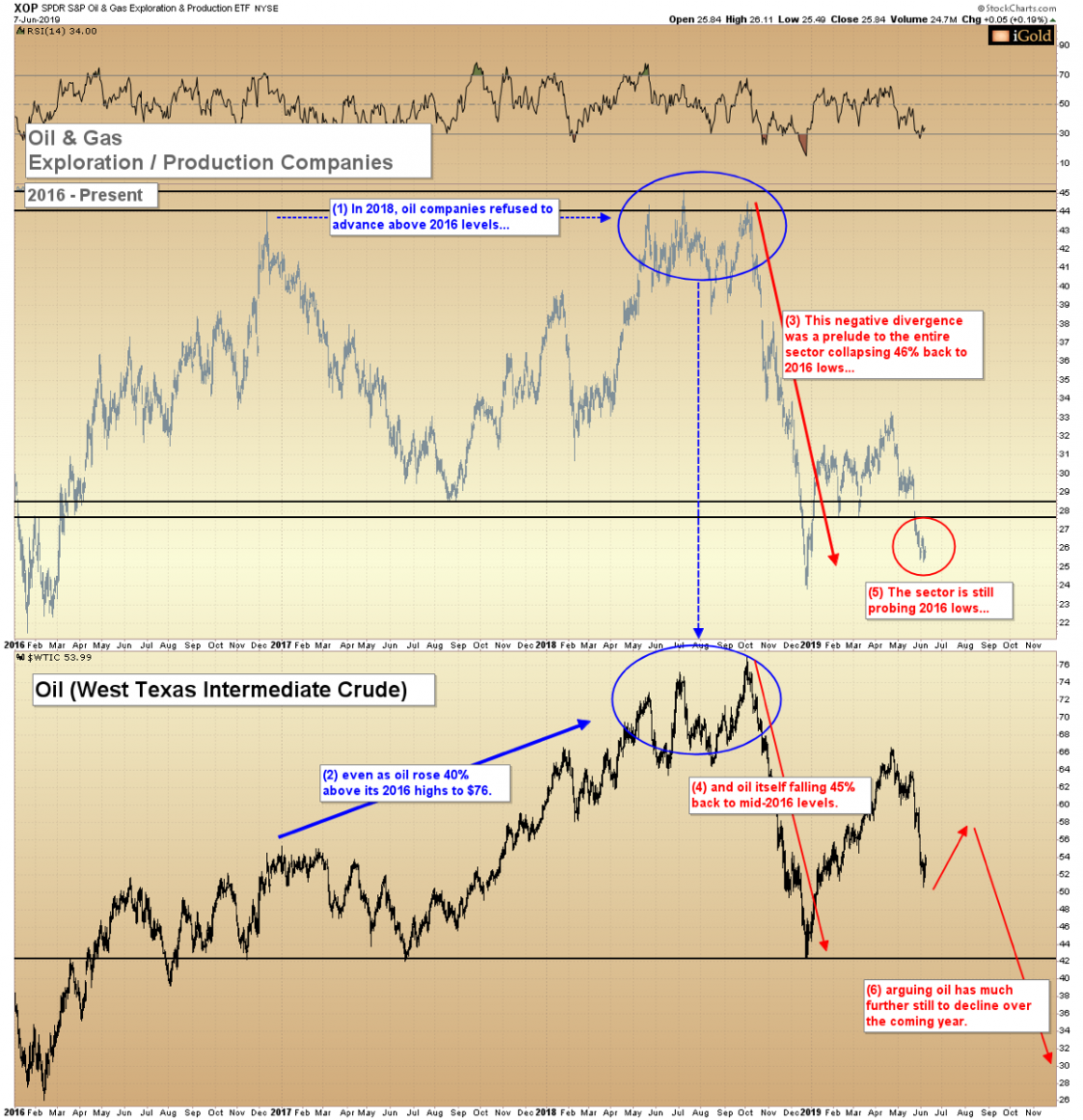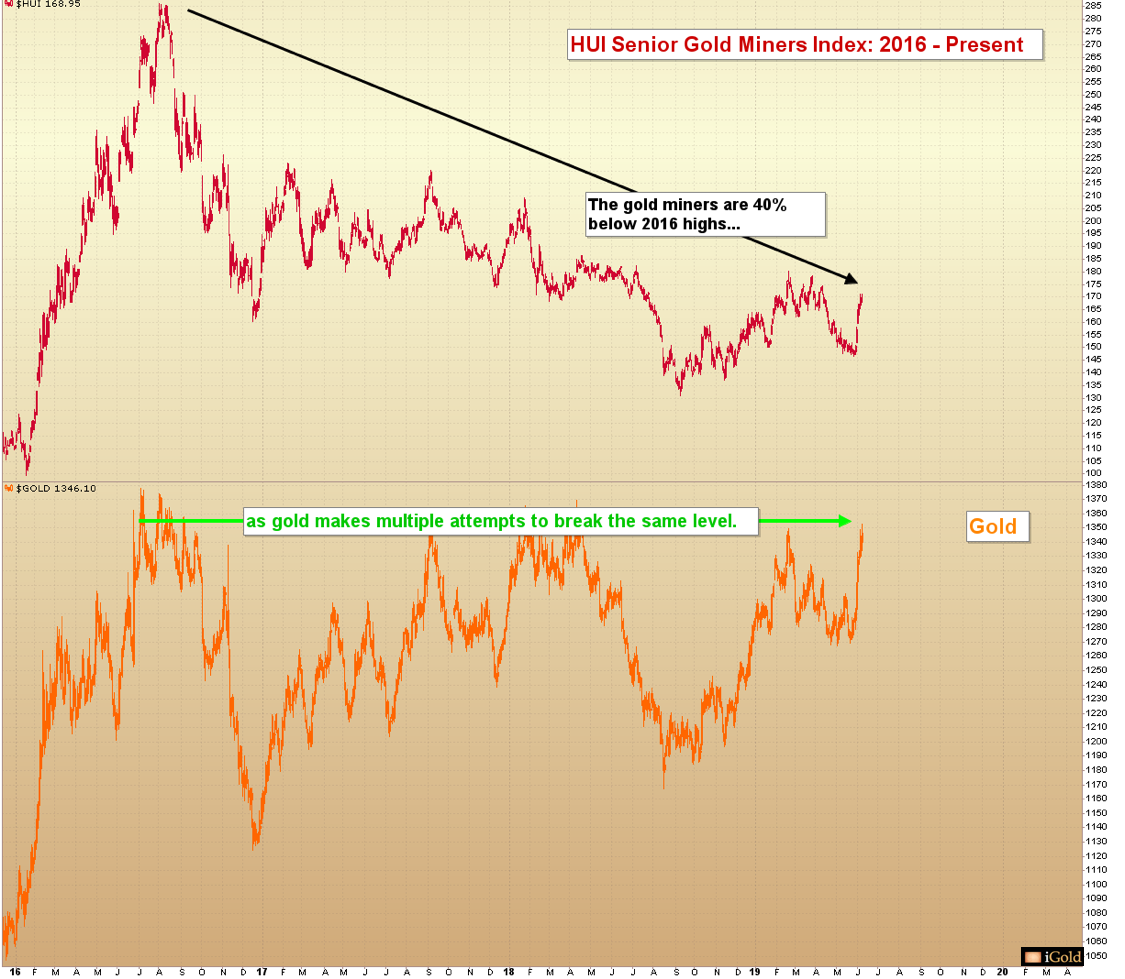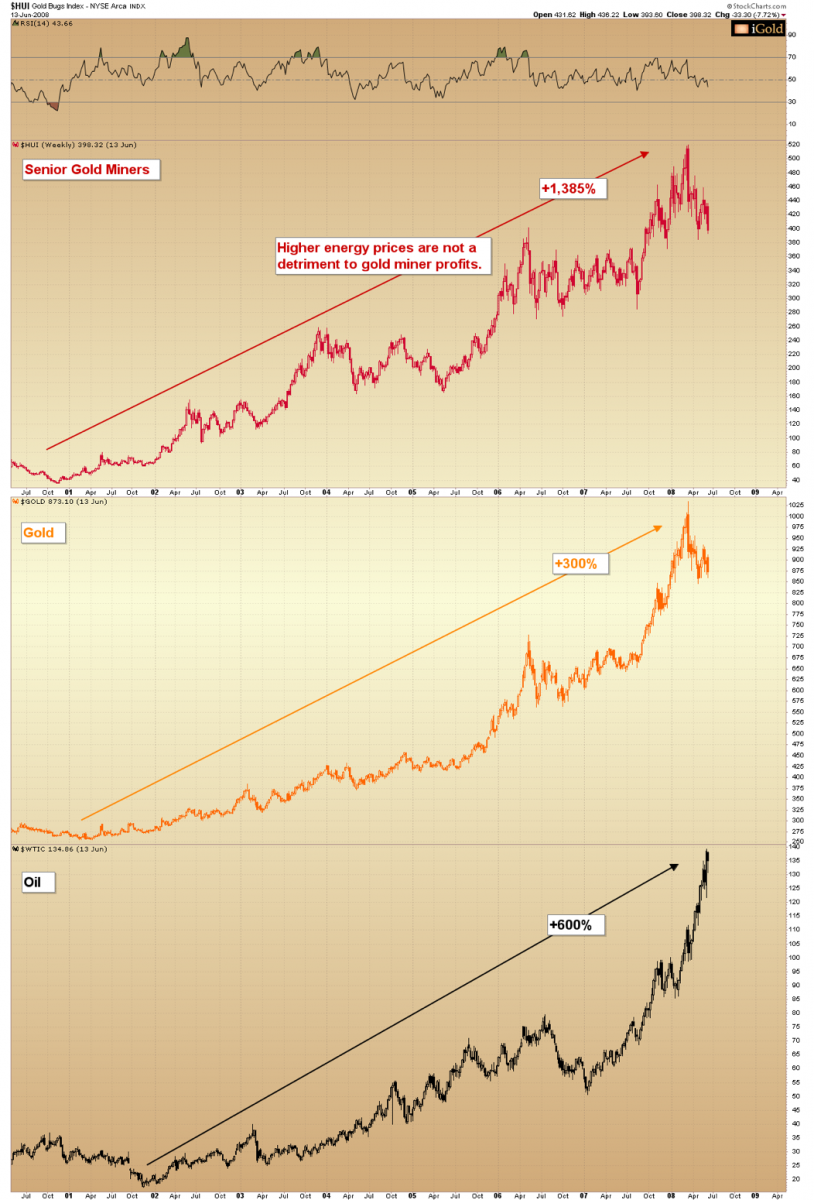Gold Price Forecast: Leading Signal Points Lower

Gold has been hot recently, up $35 last week alone and $75 in the previous three weeks on the heels of increased trade tensions and speculation that the Federal Reserve might cut interest rates this year. Prices closed at $1,344 on Friday afternoon before falling back some in early Monday morning trading.
Despite recent gains, there is an important warning signal developing within the gold market that investors should be aware of. This signal points to a significant reversal lower within the coming 12-18 months, even if gold still has further room to run to the upside over the short-term.
History of the Signal
There is a striking similarity between the negative scenario that is developing in the gold sector and the same warning signal which recently was proven correct in the oil market.
Oil is, after all, often called “liquid gold.” We can learn much about what to expect from gold in studying the oil example.
Below we plot the oil and gas production / exploration companies (XOP) on top, with the price of their primary product – oil – below, since 2016:
The chart has six major annotations, labeled accordingly:
- (Top, blue) - Following the 2016 surge in oil prices, note how by 2018 the oil companies refused to advance beyond their 2016 levels.
- (Bottom, blue) - Meanwhile, the price of oil rose by another 40% above its 2016 peak, from $55 to $76 per barrel. All the while, the oil producers refused to make a new high.
- (Top, red) - This negative divergence, in which the producers did not believe the advance in the oil price, was a prelude to a 46% collapse in equity values across the sector after oil peaked in 2018.
- (Bottom, red) - Meanwhile, oil itself fell 45% back to mid-2016 levels.
- (Top, red) - Even on 2019’s recovery in oil from $42 to $66 per barrel, the oil producers failed to meaningfully advance, and are still probing 2016 lows.
- (Bottom, red) - This negative divergence again shows oil still has further to decline, likely toward the related 2016 lows near $26 per barrel.
Key Takeaway on Oil Producers
The principal component of oil companies’ revenue comes from the price of oil itself.
When the sum of the sector fails to materially advance over a multi-year period amidst rising oil prices, it argues that oil investors as a whole are using the period to sell their stock.
Why would oil company investors sell their stock amidst rising oil prices? Only because they believe the elevated prices will not last.
As a sum, in 2018 oil company investors successfully predicted that oil prices above $55 were not sustainable.
Same Signal for Gold Prices
This is the exact same signal which is developing in the precious metals sector. Oil gives us a prime example as per how this negative divergence can manifest, how long the signal can last, and what the ultimate outcome should be.
Note that the oil price rose 40% above its 2016 highs, even as the production companies failed to advance. In percentage terms, this 40% advance would be equivalent to gold prices rising to $1,929 per ounce, yet with the gold miners failing to exceed their 2016 peaks!
Let those numbers sink in for a moment – we imagine this level of a divergence to be unfathomable, but this is the math of what has just transpired for oil investors.
Of course, oil is often more volatile than gold – in both directions:
- From its 2016 low to its 2018 high, oil rose from $26 to $76 per barrel, nearly 200%.
- This, as gold rose from $1,045 to $1,378, only 32%.
- Conversely, oil had previously fallen from its 2008 peak of $147 per barrel down to $26, an 82% loss.
- Gold had fallen from its 2011 peak of $1,923 down to $1,045, a lesser 45% loss.
Still, although oil is more volatile, the point is that we are witnessing the exact same negative divergence now in the precious metals’ world:
When we evaluate gold prices, similar to oil prices in late-2017, it is showing signs of wanting to break its 2016 peaks.
Meanwhile, the gold miners remain some 40% below their respective highs.
What is setting up in gold over the next 18 months is a market that will likely inflict significant losses on the majority of investors who chase prices higher without implementing strict protection rules, as most will ignore the divergence until a collapse.
Unfortunately, the longer the divergence takes to properly synchronize, the more significant the negative outcome eventually will be.
Other Reasons For Gold Miners Lagging?
We know that the miners are not lagging due to declining gold production, for total gold extracted from the Earth via mining hit an all-time high in 2018 (data courtesy Thomson Reuters):
Importantly, 2018 was the largest year-over-year growth in the last four years. Clearly, lower production is not the problem impacting miner valuations.
Further, we know that rising input costs (oil or energy prices) are not to blame.
For example, below we can see how during the 2001 – 2008 advance in gold, oil prices rose twice as high in percentage terms as gold (600% gain for oil compared to 300% gain for gold).
This sharp increase in input costs did not stop the gold miners from greatly leveraging those higher gold prices, up 1,385% in seven years compared to gold’s 300% rise.
The point is: the gold mining sector is most accurately valued based on the future expected gold price. Neither production levels nor input costs can explain the negative divergence that we have been witnessing in gold versus the miners since the 2016 peak.
The only reasonable answer is: gold mining investors as a sum do not believe the present price of gold. When viewed over a multi-year period, this negative signal has never been wrong.
Gold Can Ignore the Signal For Years
Unfortunately, gold can continue to advance over the short and intermediate-term, despite this signal. Such a display will suck in most mainstream investors at exactly the wrong moment.
As we saw in the oil example on page 1, the underlying commodity can continue to move higher for over a year as the producers diverge.
If gold indeed breaks 2016 highs at $1,378 over the coming months, we will view any further advances in either gold or the miners as opportunities to sell prior to a major multi-year reversal lower.
We can either ignore, or we can prepare, for what is emerging based on observable data.
On Sound Money
Note that this expectation of lower metals prices has no bearing on our ethical nor philosophical support of sound money. Indeed, we believe the world would be a much better place if fiat currencies were once again replaced by gold-backed money, so that politicians and central bankers could not manipulate the money supply according to their whims.
There remains great work to be done in this realm over the coming decades.
At the same time, we can see that the market itself is setting up for significantly lower gold prices, pending any final rally. This is the difference between “what is” and “what should be.”
Takeaway on Gold
The prudent precious metals investor will, at this time, understand that geopolitically-based tensions are providing momentum to carry the gold price higher. However, the sum of the gold mining investors do not believe this price action. Time and time again throughout history, we see this signal provide an early warning for major reversals lower.
A perfect example of this negative divergence has just unfolded in the oil sector. It took several years to develop, but oil production investors were ultimately proven correct as valuations have collapsed back to 2016 lows.
Thus, any further advances in gold and/or the mining sector, over the 12 – 18 month period ahead, should be viewed as opportunities to sell and to divest of non-core holdings, rather than to chase price higher.
These general expectations will guide our firm’s strategy over the intermediate timeframe. Investors may learn more about our research and consultations by visiting www.iGoldAdvisor.com
At some point in the future, another major low will develop from which a sustainable advance may begin. That time does not appear to be immediately in front of us, however.
*********






















